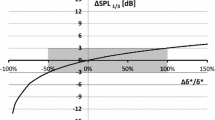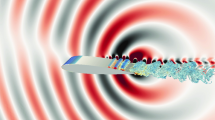Abstract
The aim of this study is to analyze the effects of trailing edge bluntness on airfoil tonal noise generation and propagation at low Reynolds numbers. Several simulations are conducted for a NACA0012 airfoil at four different free-stream Mach numbers, \(M_{\infty }\) = 0.2–0.5. The angle of incidence is set equal to 3°, and the Reynolds number based on the airfoil chord is \(Re_{c}\) = 5,000. The effects of compressibility on sound generation and propagation are analyzed along with the effects of scattering by blunt trailing edges with four different radii of curvature. Sound generation by vortex shedding is computed by a hybrid method and an accurate two-dimensional direct calculation, and results are compared. The hybrid approach uses direct calculation for near-field source computations and the Ffowcs Williams–Hawkings equation as the acoustic analogy formulation. Numerical results show that the airfoil emits an intense “narrow-band” tone and that a thicker trailing edge emits higher noise levels than a thinner one since the magnitude of quadrupole sources is larger for the thicker configuration. Moreover, the spatial distribution of quadrupole sources shows that the peak quadrupole values are closer to the surface when the trailing edge is thicker, which, again, increases the scattered far-field noise.











Similar content being viewed by others
Abbreviations
- \(c_{\infty }\) :
-
Free-stream speed of sound
- \(c\) :
-
Airfoil chord
- \(E\) :
-
Total energy
- \(f\) :
-
FW-H surface
- \(F_i\) :
-
Dipole source
- \(G\) :
-
Green’s function
- \(g_{ij}\) :
-
Covariant metric tensors
- \(g^{ij}\) :
-
Contravariant metric tensors
- \(H\) :
-
Heaviside function
- \(H_0^{(2)}\) :
-
Hankel function of the second kind and order zero
- \(i\) :
-
Imaginary unit
- \(M_{\infty }\) :
-
Free-stream Mach number
- \(q_{j}\) :
-
Heat flux
- \(p\) :
-
Pressure
- \(Pr\) :
-
Prandtl number
- \(Q\) :
-
Monopole source
- \(Re_{c}\) :
-
Reynolds number based on airfoil chord \(c\)
- \(t\) :
-
Time
- \(T\) :
-
Temperature
- \(T_{ij}\) :
-
Quadrupole source (Lighthill stress tensor)
- \(u_i\) :
-
Fluid velocity
- \(u^i\) :
-
Contravariant velocity components
- \(U_i\) :
-
Mean flow velocity
- \(\mathbf {x}\) :
-
Observer position
- \(\mathbf {y}\) :
-
Source position
- \(\gamma\) :
-
Ratio of specific heats
- \(\delta _{ij}\) :
-
Kronecker delta
- \(\rho\) :
-
Density
- \(\tau _{ij}\) :
-
Viscous stress tensor
- \(\omega\) :
-
Angular frequency
- \(\kappa\) :
-
Thermal conductivity
- \({\mu }\) :
-
Dynamic viscosity coefficient
- \(\nu\) :
-
Kinematic viscosity coefficient
- \({}^{\prime}\) :
-
Perturbation value
- \(\hat{\cdot }\) :
-
Fourier-transformed quantity
References
Lockard DP, Lilley G (2004) The airframe noise reduction challenge. Tech Rep, NASA
Dobrzynski W (2010) Almost 40 years of airframe noise research: what did we achieve? J Aircr 47(2):353–367. doi:10.2514/1.44457
Lele SK, Nichols JW (2014) A second golden age of aeroacoustics?. Philos Trans R Soc Math Phys Eng Sci 372(2022). doi:10.1098/rsta.2013.0321
Smith DL, Paxson RP, Talmadge RD, Hotzo ER (1970) Measurements of the radiated noise from sailplanes. Tech Rep, US Air Force Flight Dynamics Laboratory, pp 114
Clark LT (1971) The radiation of sound from an airfoil immersed in a laminar flow. J Eng Gas Turbines Power 93(4):366–376. doi:10.1115/1.3445595
Hersh AS, Hayden RE (1971) Aerodynamics sound radiation from lifting surfaces with and without leading edge serrations. Tech Rep, NASA, pp 102
Longhouse RE (1977) Vortex shedding noise of low tip speed, axial flow fans. J Sound Vib 53(1):25–46. doi:10.1016/0022-460X(77)90092-X
Fink MR, Schlinker RH, Amiet RK (1976) Prediction of rotating-blade vortex noise from noise of non-rotating blades. Tech Rep, NASA, pp 119
Arbey H, Bataille J (1983) Noise generated by airfoil profiles placed in a uniform laminar flow. J Fluid Mech 134:33–47. doi:10.1017/S0022112083003201
Paterson RW, Vogt PG, Fink MR, Munch CL (1973) Vortex noise of isolated airfoils. J Aircr 10:296–302. doi:10.2514/3.60229
Tam CKW (1974) Discrete tones of isolated airfoils. J Acoust Soc Am 55(6):1173–1177. doi:10.1121/1.1914682
Fink MR (1975) Prediction of airfoil tone frequencies. J Aircr 12(2):118–120. doi:10.2514/3.44421
Brooks TF, Pope DS, Marcolini MA (1989) Airfoil self-noise and prediction. Tech Rep, NASA, pp 145
Nash EC, Lowson MV, Mcalpine A (1999) Boundary-layer instability noise on aerofoils. J Fluid Mech 382:27–61. doi:10.1017/S002211209800367X
Desquesnes G, Terracol M, Sagaut P (2007) Numerical investigation of the tone noise mechanism over laminar airfoils. J Fluid Mech 591:155–182. doi:10.1017/S0022112007007896
Kurotaki T, Sumi T, Atobe T, Hiyamae J (2008) Numerical simulation around NACA0015 with tonal noise generation. In: Proceedings of the 46th AIAA aerospace sciences meeting and exhibit, Reno. Paper No. 2008–672. doi:10.2514/6.2008-672
Chong TP, Joseph P (2009) An experimental study of tonal noise mechanism of laminar airfoils. In: 15th AIAA/CEAS aeroacoustics conference (30th AIAA aeroacoustics conference). doi:10.2514/6.2009-3345
Tam C, Ju H (2011) Airfoil tones at moderate reynolds number: a computational study. In: Proceedings of the 17th AIAA/CEAS aeroacoustics Conference (32nd AIAA aeroacoustics conference), Portland. Paper No. 2011-2711. doi:10.2514/6.2011-2711
Hutcheson F, Brooks T (2004) Effects of angle of attack and velocity on trailing edge noise. In: 42nd AIAA aerospace sciences meeting and exhibit, aerospace sciences meetings. doi:10.2514/6.2004-1031
Lele SK (1992) Compact finite difference schemes with spectral-like resolution. J Comput Phys 103(1):16–42. doi:10.1016/0021-9991(92)90324-R
Nagarajan S, Lele SK, Ferziger JH (2003) A robust high-order compact method for large eddy simulation. J Comput Phys 191(2):392–419. doi:10.1016/S0021-9991(03)00322-X
Beam RM, Warming RF (1978) An implicit factored scheme for the compressible navier-stokes equations. AIAA J 16(4):393–402. doi:10.2514/3.60901
Nagarajan S, Lele S (2005) Sound generation by unsteady airfoil motions: a study using direct computation and acoustic analogy. In: 11th AIAA/CEAS aeroacoustics conference (30th AIAA aeroacoustics conference). doi:10.2514/6.2005-2915
Nagarajan S, Lele SK, Ferziger JH (2007) Leading-edge effects in bypass transition. J Fluid Mech 572:471–504. doi:10.1017/S0022112006001893
Wolf WR, Lele SK (2010) Acoustic analogy formulations accelerated by fast multipole method for two-dimensional. AIAA J 48:2274–2285. doi:10.2514/1.J050338
Wolf WR, Azevedo JLF, Lele SK (2012) Convective effects and the role of quadrupole sources for aerofoil aeroacoustics. J Fluid Mech 708:502–538. doi:10.1017/jfm.2012.327
de Lacerda LA, Wrobel LC, Mansur WJ (1996) A boundary integral formulation for two-dimensional acoustic radiation in a subsonic uniform flow. J Acoust Soc Am 100(1):98–107. doi:10.1121/1.415871
Lockard D (2000) An efficient, two-dimensional implementation of the Ffowcs william and hawkings equation. J Sound Vib 229(4):897–911. doi:10.1006/jsvi.1999.2522
Acknowledgments
The authors acknowledge the financial support received from Fundação de Amparo à Pesquisa do Estado de São Paulo, FAPESP, under Grant Nos. 2014/10166-6, 2013/03413-4 and 2013/07375-0, the financial support received from Conselho Nacional de Desenvolvimento Científico e Tecnológico, CNPq, under Grant No. 470695/2013-7 and the financial support received from Pró-Reitoria de Pós-Graduação da Universidade Estadual de Campinas, PRP-UNICAMP, under FAEPEX Grant No. 259/2014. The authors also thank to Centro Nacional de Processamento de Alto Desempenho em São Paulo, CENAPAD-SP, for providing the computer resources for the numerical simulations under project 551. The authors also acknowledge Coordenação de Aperfeiçoamento de Pessoal de Nível Superior, CAPES, and FAPESP for providing a MSc. scholarship to the first author.
Author information
Authors and Affiliations
Corresponding author
Additional information
Technical Editor: Francisco Ricardo Cunha.
Rights and permissions
About this article
Cite this article
Arias Ramírez, W., Wolf, W.R. Effects of trailing edge bluntness on airfoil tonal noise at low Reynolds numbers. J Braz. Soc. Mech. Sci. Eng. 38, 2369–2380 (2016). https://doi.org/10.1007/s40430-015-0308-6
Received:
Accepted:
Published:
Issue Date:
DOI: https://doi.org/10.1007/s40430-015-0308-6




